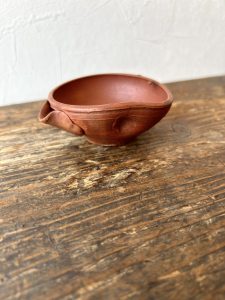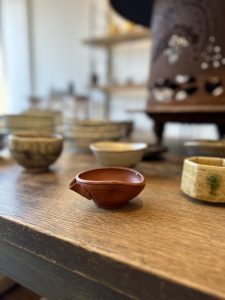ちょっとしたストレスを解消してくれるもの(愛知県名古屋市千種区姫池通 骨董買取 古美術風光舎)
2024.03.13
皆さまこんにちは。スタッフHでございます。
今日の名古屋は風が強く、歩いていても前に進むのが大変でした。強風の中を歩くと疲れが倍増する気がいたします。
さて、風光舎にございます備前焼の片口。直径6cmほどの小ぶりの器ですが、たくさんの器の中にあっても目を引きます。作った方の指の動きが感じられ温かみもあり、握ってみると横のくぼみが親指にフィットします。手に馴染むよう、注ぎやすいようにと計算しつくされている気がします。

片口は鎌倉時代に使われていた銚子と呼ばれる柄のついた酒器から由来し、両側に注ぎ口のあるものを両口(もろくち)、片側だけにあるものを片口(かたくち)と呼んでいたそうです。
ワインをデキャンタに注ぐことをデキャンタージュといいますが、あえて空気に触れさせることで、香りを立たせ味をまろやかにする効果があります。片口にも似たような効果があり、日本酒も空気に触れることで味がまろやかになるそうです。
冷蔵庫などで保管されていた吟醸酒などは、冷蔵庫から出したばかりの時は雪冷え(5℃)の状態です。すっきりとした味わいを楽しめますが香りや甘味は感じにくいようです。花冷え(10℃)から涼冷え(15℃~20℃)くらいの温度になると香りが一層引き立ち甘みも強く感じられるとのこと。片口に注いでおけば、そこからゆっくり香りや甘みを楽しめます。
特に備前焼は内部に微細な気孔があり若干の通気性もあるため、さらにお酒の香りやまろやかさを感じることができそうです。
かなり機能的な器ではありますが、その見た目も魅力の一つです。鳥のくちばしのような注ぎ口が愛らしく、置いておくだけでも目の保養になりそうです。
以前からこちらの風光舎の片口の注ぎ口の形状が気になっていました。思い切って試しに水を入れて注いでみると、想像以上に滑らかに水が注がれ感動しました。液体をそそぐ器を選ぶ際、お酒などの液体のキレが大切だといわれます。注ぐたびに液体が垂れるのはちょっとしたストレスになりますよね。

注ぎやすさの条件としては注ぎ口が狭い方がキレが良いとされています。また注ぎ口の付け根にやや膨らみのある方が使い勝手がいいとのこと。このふくらみにより液体が一気に流れ出ることがなく適量が注がれるそうです。そういえば急須も注ぎ口の付け根がふくらんだものが多いですね。風光舎の片口の注ぎ口も無造作に見えて、液体が一気に流れ出ないように工夫されています。穴の大きさや注ぎ口の角度など作り手の技量が問われそうです。
ふとひらめいたのですが、小ぶりの片口は液体だけではなく、塩や七味などのスパイスを入れて食卓に置くのもいいかもしれません。瓶から振り入れたり、ちいさな匙ですくって入れるより調節しやすそうな気がします。試してみたい衝動に駆られております。
またまた余談ですが、卵料理を作る時に溶いた卵をフライパンなどに流し入れた後、器に残った卵液が器の外に垂れてしまうのが私のちょっとしたストレスでした。先ほど注ぎ口についてしらべておりましたら、卵液が垂れるのを防止する方法というのを見つけました。卵液をフライパンに流し入れた後の器をそのまま上に向けず、くるっと下向きに前転させるように回すのだそうです。それだけ?と思いましたが明日の朝、ぜひ試してみようと思います。
それでは、また次の機会に。

Hello everyone. This is Staff H.
It was very windy in Nagoya today, and it was hard to move forward even when walking. I feel that walking in a strong wind makes me twice as tired.
Now, I would like to introduce a Bizen ware “Katakuchi” at Fuhkosha. It is a small vessel with a diameter of about 6 cm, but even among so many other vessels, it catches the eye. The movement of the maker’s fingers can be felt and it has a warmth, and when you hold it, the indentation on the side fits your thumb. I feel that it has been carefully calculated to fit comfortably in the hand and to make it easy to pour.
The name “katakuchi” comes from a sake bottle with a handle called choshi, which was used in the Kamakura period (1185-1333), and those with a spout on both sides were called morokuchi (double spout), while those with a spout on only one side were called katakuchi (single spout).
Decanting is the process of pouring wine into a decanter, and the effect of allowing the wine to come into contact with the air is to bring out the aroma and mellow out the flavor. Sake also mellows out when exposed to air.
Sake that has been stored in a refrigerator, such as ginjo-shu, is snow-cold (5°C) when it is just taken out of the refrigerator. It has a refreshing taste, but its aroma and sweetness are not as pronounced. At temperatures between 10℃ and 15℃ to 20℃, the aroma is more pronounced and the sweetness is stronger. If poured into a single sip, the aroma and sweetness can be enjoyed slowly from there.
In particular, Bizen ware has minute pores inside and some ventilation, so it is likely to further enhance the aroma and mellowness of the sake.
Although the vessel is quite functional, its appearance is also one of its charms. The bird’s beak-like spout is adorable, and just by placing it on the table it seems to be a feast for the eyes.
I have long been curious about the shape of the spout of this Fukosha’s one-way spout. When I took the plunge and poured a glass of water into it, I was impressed by how smoothly the water poured out, much smoother than I had imagined. When selecting a vessel for pouring liquids, it is said that the sharpness of liquids such as sake is important. It would be a little stressful if the liquid dripped every time you poured, wouldn’t it?
The narrower the spout, the better the sharpness of the liquid. Also, a slight bulge at the base of the spout is better for ease of use. This bulge is said to prevent the liquid from flowing out all at once, allowing the right amount to be poured. Come to think of it, many kyusu also have a bulge at the base of the spout. The spout of Fukosha’s katakuchi also appears to be random, but it is designed so that the liquid does not flow out all at once. The size of the hole, the angle of the spout, and other details seem to test the skill of the maker.
It suddenly occurred to me that the small one end spout could be used not only for liquids, but also for spices such as salt and shichimi (seven spices) to put on the table. I think it would be easier to adjust than shaking it in from a jar or scooping it in with a tiny spoon. I am tempted to give it a try.
On a side note, it has been a little stressful for me when cooking eggs, because after pouring the beaten eggs into a frying pan or other container, the remaining egg liquid drips out of the container. I was just researching about spouts and found a way to prevent the egg mixture from dripping out of the bowl. It seems that after pouring the egg mixture into the frying pan, the bowl should not be turned up, but instead rotated forward and downward. Is that all? I thought, “Is that all?” but I will definitely give it a try tomorrow morning.
See you next time.
**********************
ご実家の整理やお片付けなどをされている方のご相談などが多くございます。
お片付けなどくれぐれもご無理のないようになさってくださいませ。
風光舎では古美術品や骨董品の他にも絵画や宝石、趣味のお品など様々なジャンルのものを買取しております。
お片付けをされていて、こういうものでもいいのかしらと迷われているものでも、どうぞお気軽にご相談下さいませ。
また風光舎は、出張買取も強化しております。ご近所はもちろん、愛知県内、岐阜県、三重県その他の県へも出張いたします。
まずは、お電話お待ちしております。
愛知県名古屋市千種区姫池通
骨董 買取【古美術 風光舎 名古屋店】
TEL052(734)8444
10:00-18:00 OPEN
#骨董買取#古美術買取#出張買取#無料査定#生前整理#遺品整理#家じまい#実家じまい#掛け軸#絵画#木箱入り茶碗#刀剣#洋食器#貴金属

